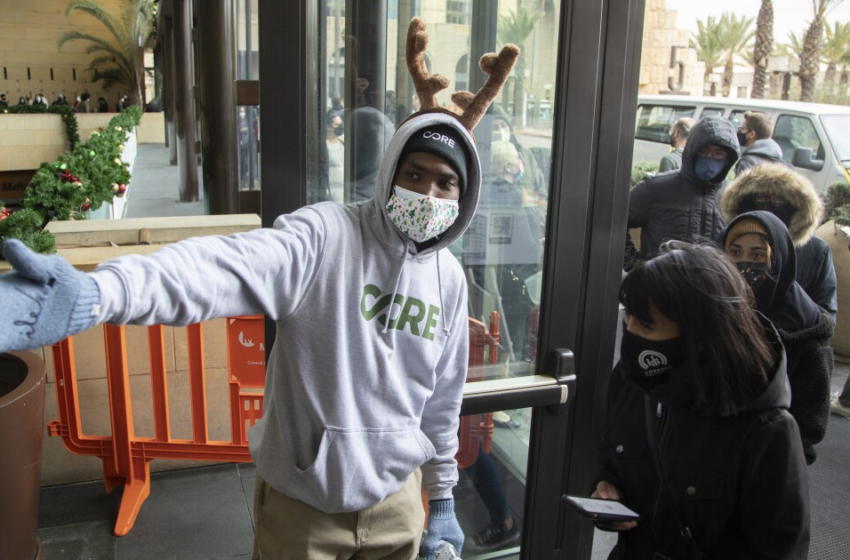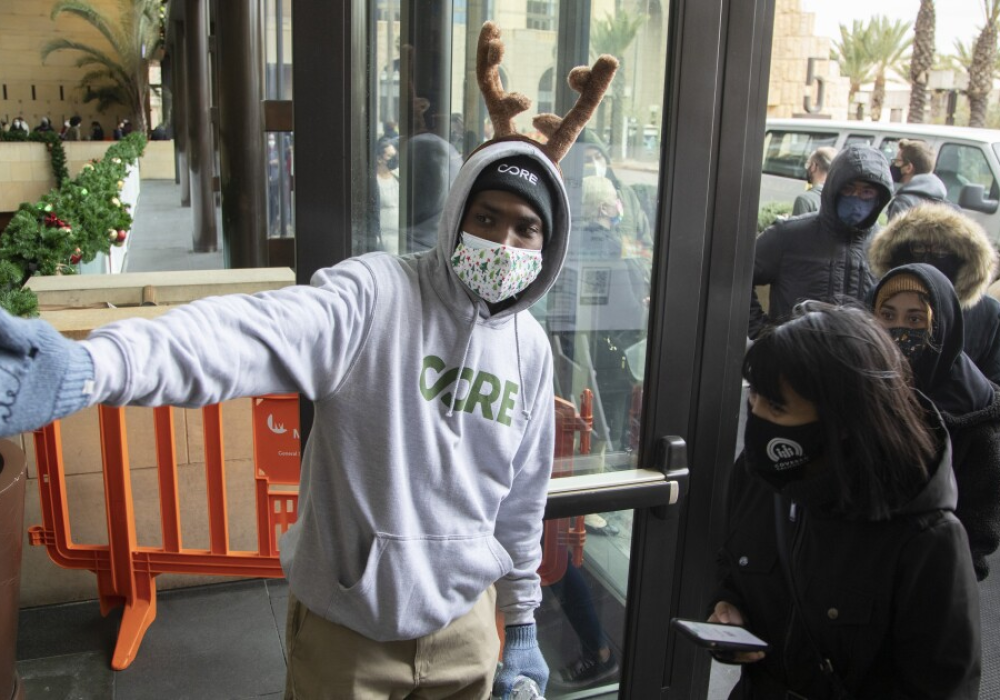COVID-19 hospitalizations are rising rapidly in California, placing fresh strain on healthcare systems worn thin by nearly two years on the frontlines of the pandemic.
Though the number of COVID-19 patients statewide remains far below the high marks seen during last winter’s surge, the daily count has swelled — a likely byproduct of a spike in coronavirus cases that officials say is being fueled by the heavily mutated Omicron variant.
California recorded 4,378 coronavirus-positive patients in hospitals Monday, an increase of 377 from the day before. The number of Californians hospitalized with COVID-19 has swelled by nearly 25% since Dec. 20.
The rise has been even steeper in Los Angeles County — which saw its daily patient count grow by 43% since Dec. 20, from 748 to 1,069. Orange County reported a 71% increase during the same time, from 188 to 322.
It’s unclear how many of the new hospitalizations are due to Omicron or whether the Delta variant remains dominant.
Though there are some data indicating that Omicron may cause less severe symptoms than Delta — which has long been the dominant version of the coronavirus circulating in California — health officials have noted that a significant uptick in infections is still likely to send many patients to the hospital.
“Our case rates are going up incredibly fast, and some proportion of people that get sick will require a hospital bed,” Dr. Sara Cody, the Santa Clara County public health director and health officer, said during a news conference Tuesday.
“We are anticipating that our cases will exceed what they did last winter, so even a small proportion will have a significant impact on our hospitals, and that’s what we are concerned about.”
Overall, COVID-19 hospitalizations remain a fraction of what they were at this time last year. On Dec. 27, 2020, there were 19,766 coronavirus-positive patients hospitalized statewide, one of the highest single-day totals of the pandemic.
But that is little comfort to healthcare workers.
During a briefing last week, L.A. County Public Health Director Barbara Ferrer said she wanted to “extend my heartfelt gratitude to all of our healthcare workers and our public health workers, who really can’t believe that we’re starting to see another huge, huge surge right around holiday time.
“I know that the frustration is very real, because it just at this point seems endless and because we have some tools that provide a lot of protection, and lots of people aren’t still using them,” she said. “I think for those who are in charge of caring for us, the frustration can be overwhelming because, in general, our healthcare workers, our public health workers, are the most compassionate people in our county. They’ve dedicated themselves to caring for us when we’re at our very worst. But we’re asking a lot of them.”
Data reporting was interrupted over the recent holiday weekend, making it difficult to discern the extent of the coronavirus spread in recent days.
But some health experts have said a wave of new cases is washing over California. For the seven-day period that ended Monday, California logged 133,610 coronavirus cases. That’s higher than in any seven-day period during the summer Delta surge, which peaked at 107,000 cases recorded in a week.
L.A. County has reported at least 6,500 new cases every day for the last week, including 9,473 on Tuesday. But “most alarming,” health officials wrote in a statement, “is the increase in test positivity, which has more than tripled since mid-December, indicating surging transmission across the county.”
As of Tuesday, the seven-day average countywide positivity rate was 14.5%.
“While we all wish that 2022 would begin without the continued tragedy of serious illness and death associated with COVID, we are instead facing the prospect of an alarming surge that requires every person to act with intentionality: Get vaccinated and boosted, get tested and, please, always wear a mask around others,” Ferrer said in a statement Tuesday. “These are the tools we have to try to keep each other safe over the holidays.”
California is not alone in its uptick.
The Centers for Disease Control and Prevention reported Tuesday that the nationwide average number of daily cases over the last week has climbed to 206,000, exceeding the peak of 160,000 during the summer Delta surge and approaching the all-time high of 250,000 reported last winter.
Many have attributed the mushrooming case counts to the spread of Omicron, which is possibly the most transmissible variant of the coronavirus yet. Federal health officials estimate that Omicron accounts for the majority of new coronavirus cases nationwide.
According to data released last week by the California Department of Public Health, at least three state health systems have reported that Omicron appears to account for 50% to 70% of new cases — though officials stressed that full sequencing is still underway.
The variant’s rapid rise was not unexpected. About two weeks ago, Cody warned of “a deluge of Omicron.”
“Today, unfortunately, that deluge is here,” she said. “Our cases here in Santa Clara County are spiking, and the vast majority of them are Omicron.”
There’s growing evidence that Omicron presents an increased risk of reinfection with the virus and that past infection alone, without vaccination and masking, does not guarantee protection against another COVID-19 illness.
However, the CDC this week also reduced its recommended isolation and quarantine period for those who are infected with the coronavirus but have no symptoms from 10 days to five. Gov. Gavin Newsom said California would align itself with the updated guidelines.
Officials — who are urging people to avoid large indoor gatherings for New Year’s Eve — say the best way for residents to armor themselves against infection and serious illness is to get vaccinated and, if eligible, get a booster.
From Dec. 2 to 8 — the week after Omicron was first detected in the state — unvaccinated Californians were nearly eight times more likely to be infected than their fully vaccinated counterparts, state data show.
And from Nov. 25 to Dec. 1, the most recent week for which complete data are publicly available, unvaccinated people were roughly 12 times more likely to be hospitalized with COVID-19 than those who had been fully vaccinated, according to the state.
Over the weeklong period to Dec. 11, unvaccinated people in L.A. County were 23 times more likely to be infected than vaccinated people who had received a booster shot, officials said.
“These greatly increased risks to unvaccinated people underpin all of our work to increase vaccination and boosters for every single resident,” Ferrer said recently.
The CDC says 85% of U.S. adults have received at least one dose of COVID-19 vaccine. In California, about 95% of adults have gotten at least one dose, and 77% are considered fully vaccinated, the CDC said.
A newly released report from the U.S. Census Bureau sheds some light on the holdouts.
Among unvaccinated U.S. adults who responded to a recent survey, 42% said they don’t trust the vaccines, 35% said they don’t trust the government, and 22% said they don’t think COVID-19 is a big threat.
Only 2% of respondents said it was difficult to get the shot.
Unvaccinated adults are generally young, with 75% of them under 50. They have lower levels of education, on average; people who have received at least one vaccine dose were twice as likely to have a college degree. Additionally, unvaccinated adults are less likely to be married than vaccinated adults.










